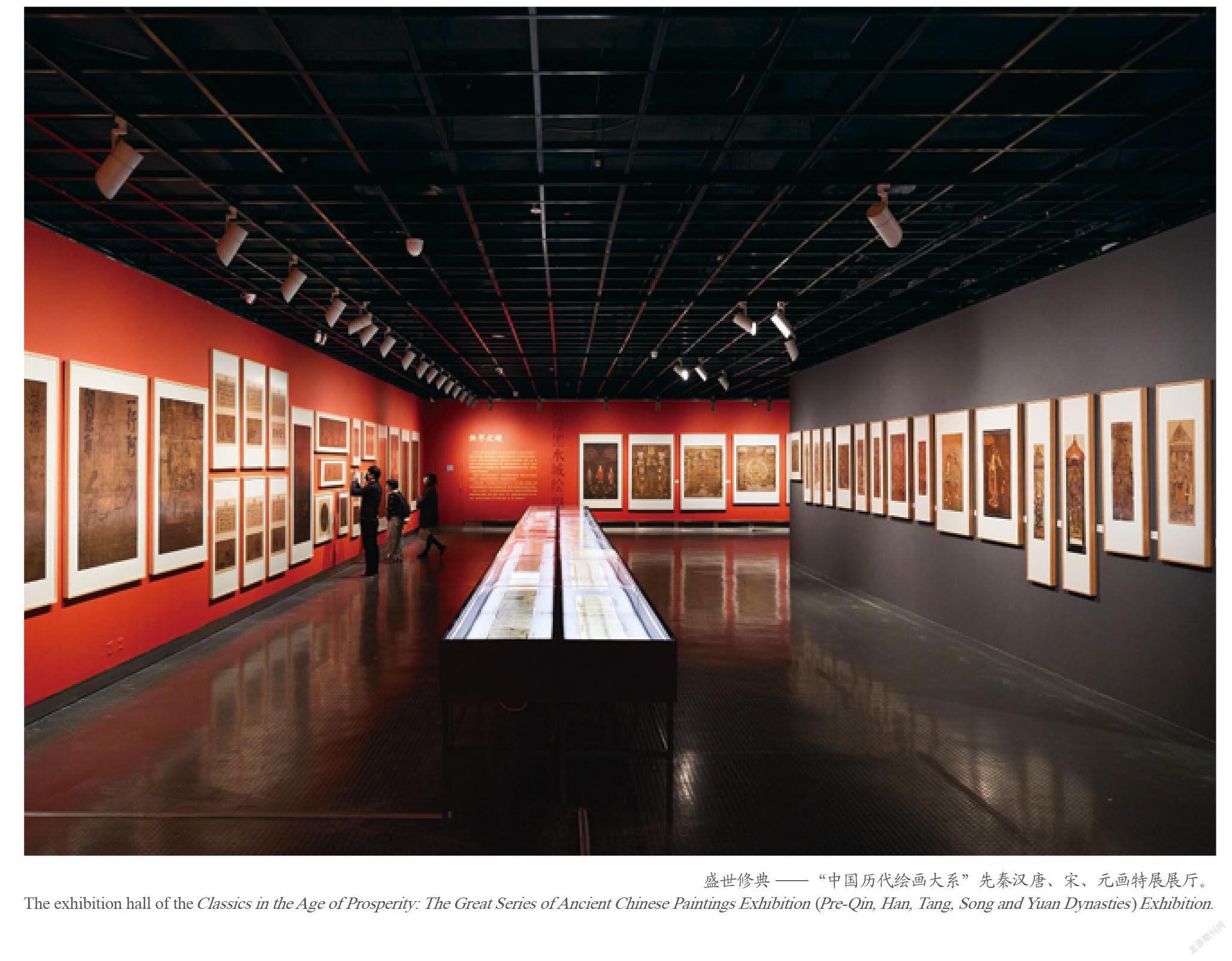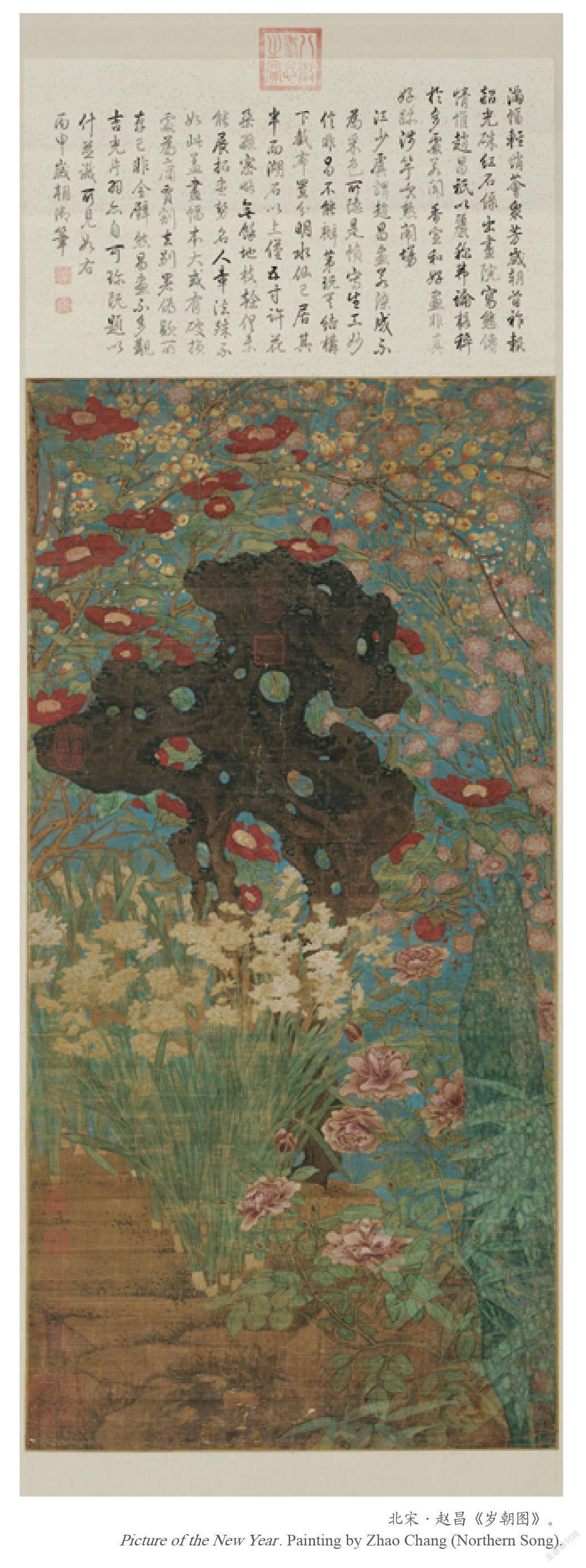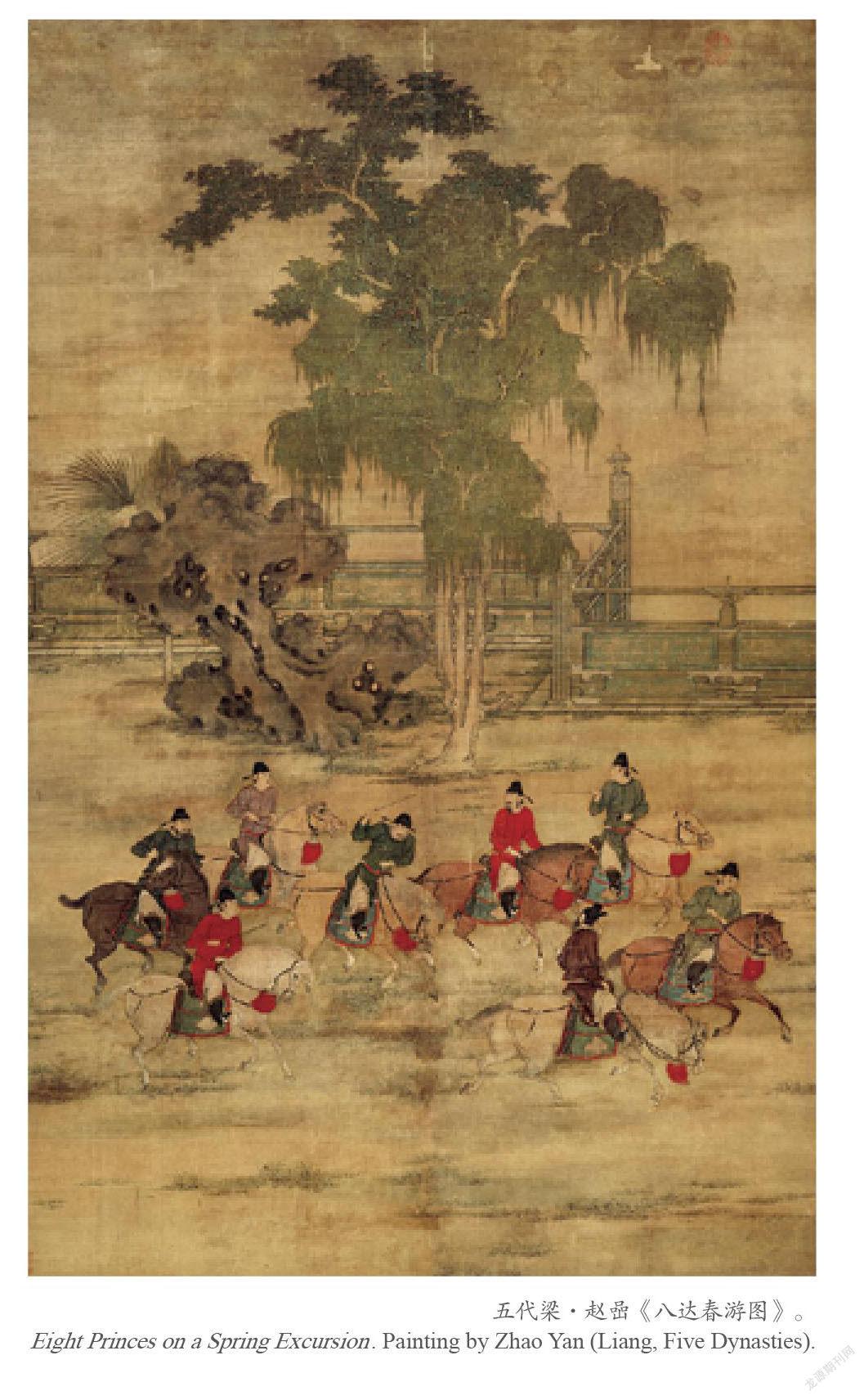丹青不老 回响千年
2022-06-08曾福泉郑梦莹王利剑
曾福泉 郑梦莹 王利剑



江南四月,草长莺飞。在明媚春色中来到杭州西子湖畔、步入浙江美术馆的人们会告诉你,他们体验了一场更加壮阔、更加绚丽、更加深刻的心灵之旅——
今年3月至4月展出的“中国历代绘画大系”(下称“大系”)先秦汉唐、宋、元画特展,以1500余件中国古代绘画精品的出版打样稿档案,为参展观众打开一条穿越千年的艺术通道,让中国优秀传统文化的光芒映照当代人的内心。
这是一场历时17年的“文化长跑”,如今即将抵达终点。“大系”团队选择在浙江美术馆呈现17年来国宝汇聚取得的成果,有其特殊意义。
从2005年到2022年,“大系”项目从启动到即将结项,横跨4个五年计划阶段。从2002年到2022年,浙江美术馆从决定筹建到今天,前后已历经20年。
一座馆,一个展。这是浙江文脉滋长生发的生动注脚,是浙江不断汲取文化自信这一“更基本、更深沉、更持久的力量”的鲜明写照。在“大系”即将圆满结项的时刻,我们置身于浙江美术馆宽阔的展览厅中,被中国历代艺术珍品重重环绕,能更深切地感悟这项工作的重大意义。
品味宋画,聆听宋韵回响
步入浙江美术馆大厅,映入眼帘的是3000多条数十米长的细线,在空中搭成一条五彩“通道”。展览总策展人之一、浙江大学艺术与考古学院副院长王小松教授说,这一设计名为“千年回响”,寓意本次展览以传世艺术珍品的汇聚重现,将传统文化与当代人的心灵相连。
经由绘画,“走进”历史。斯土斯民两千多年来的丰富生活,借翰墨丹青而充满鲜活气息。特别是本次展览精选的800余幅宋画,规模之大前所未有,描绘出宋韵的斑斓纹理,诉说着宋韵的丰沛悠长,承载着宋韵绵绵不绝的回响。
有关专家研究估计,海内外存世的两宋绘画约1200件,而“大系”项目即收录了1100余件。此次展览共展出800余件宋画数字化打样稿,皆从《宋画全集》中精选而来,数量之多、规模之大、内容之丰富,前所未见。
漫步展厅,近乎全景式展陈的两宋绘画巨制令人身心浸润其中。边走边看,我们于笔墨精微和斑斓多姿中,看见宋人的美学格调、内心追求和对世界的理解,从中领略宋韵悠长。
在一组由十多面屏幕并排成组的大型装置上,宋代杭州湖山佳胜的风姿在轮番展现的画卷中一览无余。生于杭州的南宋宫廷画师李嵩,熟悉杭州的山山水水。他的《西湖图卷》就展现在最大的一面横屏上。断桥残雪、花港观鱼……西湖十景在他的巧妙抒写下,冲融缥缈,意蕴深远。
画卷除了体现“诸法皆备”的艺术水准,折射出的更是两宋时期的时代风貌——宋之韵,包涵日常生活领域的物质之韵,生产技术领域的匠心之韵,社会运行领域的秩序之韵,发现发明领域的智识之韵,学术思想领域的思辨之韵,文学艺术领域的审美之韵……林林总总,正是宋代文化中优秀的文明元素、内在精神和传承至今的文化价值。
一路颠沛流离南渡来到杭州的画家李唐,以情入画,心中笔下时时涌动历史风烟。现为美国大都会艺术博物馆馆藏的李唐画作《晋文公复国图》,通过1:1高保真数字化打样稿在此次展览中完美重现。安静的展厅内,那一笔一划似乎在与观众对话,述说着画者收复中原的愿景和内心激荡的家国情怀。
经济繁荣、民生富足的南宋,为画家提供了新的创作视角和空间。展厅中,苏汉臣和李嵩各自创作的《货郎图》通过大屏幕呈现,与一架满载物品的实体独轮车交相辉映。“儿童闻听货郎来,蜂拥而至喜相迎。”货郎题材作品,正是对南宋商业经济繁荣、百姓生活祥和安定的直观反映。
美国克里夫兰艺术博物馆馆藏的《番王礼佛图》、日本大阪市立美术馆馆藏的《明皇避暑宫图》、中国台湾台北故宫博物院馆藏的《文姬归汉图》……随着脚步在展厅间步步深入,精品画作不断映入眼帘。山水画、人物画、风俗画、禅宗画……琳琅满目,自成体系。
千年丹青,盛世再现。利用图像、文字、新媒体科技等多元化展示手法,展览呈现了宋代绘画的宏富成就。虽是调色样稿,但经过高清拍摄后的巨制,与原画的相似度非常高。在技术加持下,大宋的万千气象更是得以清晰、灵动地展现在观众眼前。
品读这些令人叹为观止的宋画,观众得以“穿越”千年时光,徜徉于宋朝的亭台楼阁、繁华街市、日常生活当中。“太难得了,多少名画是一直想看却看不到的。”站在《清明上河图》前,一位观众看得入神,流连忘返。
的确,当观众视觉、听觉全面启动,观古今于须臾,这种非凡的体验,在此前是不曾有过的。传世宋画留给我们的不仅是艺术神韵,更是充盈着世情风物的古代文明绘影,为今人打开了一条回溯历史长河、与宋人神思交会的通途。
“数字”新生,国宝重焕光彩
数字技术赋能,数以万计的中国古代绘画珍品从历史中款步走来,开启了新的“生命奇旅”。穿梭于一个个展厅间,感受文物重焕新生。
北宋画家王希孟传世作品《千里江山图》,一向被视为中国画史上青绿山水的稀世杰作。在浙江美术馆,还原的《千里江山图》长卷被放大了数倍,陈列在主大厅入口处的展台之上,等待着观众一览匠心的独特、山河的雄壮。在灯光装置作用下,“只此青绿”,色彩更鲜明,风采更动人。
“利用技术手段,作品在被放大呈现后,很多细节甚至看得比原作更清晰。”“大系”团队有关负责人说,“大系”在图像拍摄、扫描、校色、印刷等每一步骤都有极为严格的把控,力求图像品质达到原真效果。
《溪山行旅图》《山庄图》《摹张萱捣练图》……此次展览中,不少国宝级名画都进行了放大再现,为观众、研究者提供了精确清晰、无限接近原作的观赏体验和学术研究基础。
等比例复制的敦煌、云冈、龙门、大足等四大石窟,以及四川安岳石窟、杭州西湖石窟等若干个典型洞窟,这些数字化成果汇聚一堂,让观众零距离品读中国石窟艺术和佛教艺术。
石窟复原,采用的正是全球领先的3D石窟复原技术——通过激光扫描、摄影测量技术进行数字采集,以算法进行三维模型建构,在此基础上,经由3D打印技术以及后期色彩、質感重塑,使一个个石窟跨越时空,呈现眼前。9C8C3BEA-68B8-4A0B-879F-639E336F8A77
稀世珍品有了数字档案,为后续转化成线上展览、智慧导览软件、虚拟场景体验等提供了基础。VR/AR、动态捕捉、眼动仪……本次展览以“艺术+科技”为理念,甄选来自浙江大学、中国戏曲学院等院校的近10组优秀数字艺术作品联袂展出。此外,还呈现了部分来自其他文化科技公司开发的相关应用。
来到一楼展厅,欣喜地看到不少观众正在花样体验古画创意玩法。其中,融合《山海经》元素,以“中国历代绘画大系”收录作品《九龙图》为主题打造的VR项目就吸引着不少观众。戴上设备,跟上剧情,观众便能沉浸式感受神龙腾跃于云端、灵火萦绕在周身的虚拟世界“元宇宙”。“尽管美术馆因疫情防控需要实施限流,但很多年轻人依然愿意来排队,周末更是人气十足。”展厅内一位志愿者说。
先“留”下来,再“活”起来、“火”起来。多年来,“大系”项目以数字化的方式保存了大量珍贵的文化遗产,为补写、改写、重写中国艺术史、文化史建立了数量可观、质量可靠的图像资料库。
从数字化采集,到数字化利用,共享理念贯穿始终。正因如此,历代绘画精品以另一种形式“团聚”,与观众面對面相会,让人们得以领略积淀数千年的深厚底蕴,也为文物保护和传统文化的创造性转化、创新性发展提供了新路径。
久久为功,传递文化温情
筚路蓝缕,久久为功。“大系”团队积17年之功,联合全球文博机构,汇集艺术、考古、科技等领域数百位专家学者之力,成功实现了中国古代绘画艺术从物质形态向数字形态的衍生与转化。
对“大系”团队来说,现在宛如一个丰收的时刻。特展推出以来,已有数以万计的观众为之倾倒,浙江美术馆的预约平台常常提前数天就满额。此刻回望,感慨系之。在“大系”项目启动之初,浙江大学作为主体实施单位,甚至没有一张早于清代的绘画藏品。17年来,“大系”团队秉持浙江精神,以高度的政治责任感、文化责任感,本着对民族、对国家、对历史负责的态度,先后三次开展全球范围内的中国古代绘画藏品图像搜集工作,与海内外有关文博收藏单位反复协商沟通,往来通讯、信函数以万计,实地奔波数十万公里,从而使流散海外的包括敦煌藏经洞和黑水城绘画在内3569 件(套)绘画精品,通过高精度数字化方式重返祖国怀抱,与国内8910 件(套)藏品图像“团聚”,共同构成了纵贯两千余年的中国古代绘画史的恢宏图景。
在采访本次展览策展情况时,“大系”团队多位成员首次向我们讲述了在全球新冠肺炎疫情这一重大变局冲击影响下,他们是如何克服重重困难持续推进“大系”编纂工作的。
疫情发生后,国内外博物馆一齐迎来了闭馆潮,许多海外博物馆的裁员举措更让沟通和拍摄工作变得无比艰巨。“大系”团队花了更大的努力让沟通变得更加温暖有效:将邮件准确地从英文再翻译成联络人所在国家的语言;为每一张质量不达标或者缺信息的作品制作详细的拍摄示意图;附上合同、官网和出版物的信息;和这些机构分享中国的抗疫情况和抗疫经验,送去祝福……
大英博物馆在数次闭馆期间,只要库房临时开启就会为“大系”项目拍摄敦煌藏品图片。德国国家博物馆在搬迁博物馆期间坚持拍摄作品。因疫情“失联”半年的法国国家图书馆,在再次取得联络后也尽力协助拍摄。国内外博物馆与“大系”项目17年合作所产生的信任,换来了2年间13个国家70余家博物馆在困难时刻坚持为“大系”带来1160余件全新拍摄、扫描的作品。
在疫情最为复杂严峻的那段时期,“大系”编辑们有很长一段时间无法回出版社工作,各自分散在家。编辑工作负责人把沉重的彩样图和A3纸大小的稿纸整理好,再分别邮寄或送到各编辑家中。一位编辑说,在家时把自己锁在小房间工作,稿纸摊在床上,就这样花了20多天,完成了《明画全集》董其昌卷的初审核工作。
今天流连于“大系”项目精美成果前的观众,可能很难想象这些传世珍品由“画”入“书”、从“书”到“展”所经过的艰辛历程,但是一定能通过展览感受到“大系”团队心中涌动的那份对于我们这个民族深挚的文化温情,并与之产生深深的共鸣。
Chinese Painting Special Exhibition,
a Millennium Echo
By Zeng Fuquan Zheng Mengying Wang Lijian
If you come to Hangzhou during April, a most delightful spring month in the Jiangnan (south of the Yangtze River) area, and visit the Zhejiang Art Museum at the West Lake, you will be expecting something grander, something close to your heart and soul: a giant collection is on special display here at the Zhejiang Art Museum, which comprises of over 1,500 fine prints of paintings from pre-Qin (before 221 BC), Han (202 BC-220 AD), Tang (618-907), Song (960-1279) and Yuan (1206-1368) dynasties.
This exhibition celebrates a 17-year cultural project, which is now about to complete. At this special occasion, we can feel its significance more deeply in the spacious exhibition hall of the Zhejiang Art Museum, surrounded by the historical treasures of Chinese art. Walking into the hall of the museum, your eyes will be caught by a colorful passage in the air, which is collectively formed by 3,000-odd thin threads, each more than ten meters in length. Professor Wang Xiaosong, the co-curators of the exhibition and deputy dean of the School of Art and Archaeology of Zhejiang University, explained why the design is called “Millennium Echo”: this exhibition is a collection and reproduction of precious art pieces, and it will connect traditional Chinese culture with Chinese people in the modern times.9C8C3BEA-68B8-4A0B-879F-639E336F8A77
The paintings open the door for us to walk into the history of the Song dynasty. The rich contents of local peoples lives during the past 2,000 years are vividly depicted, especially in the unprecedentedly huge selection of 800 pieces of artworks.
The painting prints are all large sized and displayed in a near panorama style for the audience to stroll around and be wholly immersed in the sea of art. For instance, on a big installation consisting of more than ten screens side by side, the beautiful sights of Hangzhous lakes and mountains in the Song dynasty are shown on the digital scrolls alternately. The largest horizontal screen displays The West Lake Scroll, a work created by Li Song (1166-1243) who was born in Hangzhou and worked as a Southern Song (1127-1279) court painter. In addition to showing the artistic standards back then, the paintings further reflect the cultural landscape of the two Song dynasties.
Using diverse new technologies, the exhibition presents the magnificent achievements of ancient Chinese painters. Although the paintings on display are in reprints, thanks to high-definition shooting they appear very similar to the original works. Looking at these breath-taking artworks makes the audience feel they are traveling through thousands of years back to the past, wandering through its bustling streets among the busy crowds.
A Panorama of Rivers and Mountains by Wang Ximeng (1096-1117) is regarded as a rare masterpiece of Chinese landscape painting. At the Zhejiang Art Museum, the reproduction of this masterpiece has been enlarged several times compared to its original size, and is displayed on a stand at the entrance of the main hall, waiting for visitors to appreciate its unique craftsmanship and the majestically rendered natural landscape. The lighting installation further enhances its color and charming style.
“Using technologies, the paintings are all presented in a magnified manner, and the audience can see many details even more clearly than in the original works, “ said the person in charge of the whole art project. For the project team, all processes, including the image shooting, scanning, color correction, printing, are under extremely strict control, in order to ensure the best quality possible.
Apart from A Panorama of Rivers and Mountains, many other reprints of national painting treasures have also been enlarged for display, letting the viewers look as closely as possible at the artworks and providing researchers with accurate and clear materials for academic research.9C8C3BEA-68B8-4A0B-879F-639E336F8A77
Beside paintings, famous caves such as the four major caves of Dunhuang, Yungang, Longmen and Maiji Mountain are also replicated 1:1. These digital achievements come together to allow visitors to appreciate Chinese cave art and Buddhist art more intimately.
Cave restoration is done by using the worlds leading 3D cave restoration technology — through laser scanning, photogrammetry technology for digital acquisition, algorithms for three-dimensional model construction. Based on the above technologies, such a cave can thus be printed, rendered in color and shaped in texture before being presented in front of the audience.
In addition, all these precious treasures have a digital archive, which provides the basis for future online exhibitions, intelligent tour software, virtual scene experiences, VR/AR, motion capture devices, eye-tracking devices ... This exhibition is based on the concept of “art plus technology”, with nearly 10 groups of outstanding digital artworks selected from Zhejiang University, the National Academy of Chinese Theater Arts and other institutions.
In the past 17 years, the art project team has been working with a high sense of political and cultural responsibilities. They have gone on three tours for a full-scale collection work, searching for images of ancient Chinese painting collections around the world. They have repeatedly negotiated and communicated with the relevant cultural institutions and museums at home and abroad, and traveled hundreds of thousands of kilometers. It is through these arduous efforts that the team has finally managed to collect 3,569 pieces/sets of paintings, putting them all through high-precision digitization and bringing them to back to China to be reunited with the other 8,910 pieces/sets from the domestic collection. Together they form a magnificent historical landscape of ancient Chinese painting spanning more than 2,000 years.
The project team also explained for the first time how they overcame hardships and kept pushing forward on schedule in the face of COVID-19: many museums closed down and even began to cut staff; during the most complicated and severe period of the epidemic, the editors of the project were unable to return to the publishing house for a long time and had to work at home separately under limited and inconvenient conditions.
Today, visitors who linger in front of the exquisite achievements of the art project may find it difficult to imagine the arduous journey of these artworks, but through the exhibition they can certainly feel the profundity of Chinese culture and resonate with it deeply.9C8C3BEA-68B8-4A0B-879F-639E336F8A77
